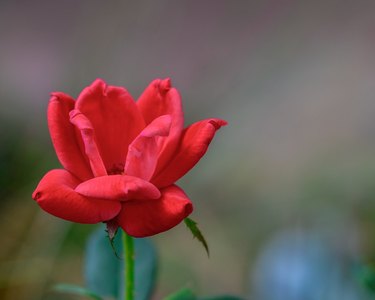
Knock Out® roses (Rosa hybrida KNOCK OUT, zones 4-11 depending on cultivar) were introduced in 2000, promising superior pest and disease resistance with the ever-blooming qualities of a landscape shrub. They remain one of the most popular and often-planted roses in home gardens, and for good reason. They are not, however, resistant to everything that nature can throw at them, and they've been found to be susceptible in particular to rose rosette disease.
Tip
If your roses are turning brown, whether they're Knock Out roses or other varieties, they've likely succumbed to environmental issues, disease or pests.
Video of the Day
Environmental Issues Causing Leaf Necrosis
Nutrient deficiencies or excesses can cause leaf necrosis in which the leaf tissues darken and wilt, turning brown before dying. In particular, a high salt level in the soil around a rose will result in the leaves turning brown and may eventually kill them.
Video of the Day
High salt is usually caused by too much fossil or synthetic fertilizer — or just plain rain if you live in a normally arid region. A concentration of above 4 dS/m (deciSiemens per meter, an electrical conductivity unit commonly used to measure salinity) can cause necrosis. To rule out a nutrient deficiency or excess, get a soil test.
Diseases That Cause Browning
Interestingly, a virulent rose disease, rose rosette, was rumored to have been spread by the Knock Out roses, but that's been debunked, since the first reportings of rose rosette were in the 1940s before Knock Out roses were introduced. However, Knock Out roses can develop rose rosette, which is initially manifested by bushy, reddish growth at the tops of stems, although it can also cause dead and dying canes with yellow or brown foliage.
At first, Knock Out roses were considered resistant to rose rosette, but they were found to harbor this disease in 2009 in Kentucky. Since then, they've been implicated in rose rosette breakouts, perhaps because some experts posit that this disease is spread by grafting. Unfortunately, the only real cure for rose rosette is to dig out and destroy the rose since there is no cure for viral plant diseases.
Other diseases that can cause leaf browning are anthracnose, downy mildew and botrytis blight — although for anthracnose and downy mildew, the leaves will usually turn brown around the edges before they curl up and fall off. For botrytis blight, flowers may develop brown spots, while mature flowers turn brown and rot quickly. You may also note gray mold with buds that form but never open.
If you observe any of these fungal symptoms, cut off the offending canes, being sure to disinfect your pruners before making each cut so you don't spread the disease further. Treat the roses with two or three fungicide treatments seven to 10 days apart to prevent spreading of the disease.
Pests That Can Affect Roses
Some pests can also cause roses to turn brown, either their leaves or the flowers. Spider mites feed on the underside of leaves, first causing a brown/translucent or spotted appearance. If unchecked, the leaves turn brown, curl and then fall off. Aphids, too, can affect the flowers and leaves, causing curling, yellowing or browning and then shedding. Once aphids have attacked a rose leaf, the leaves are also susceptible to black, sooty mold. Treat mites and aphids with beneficial insects such as lacewings or lady beetles, or hose them off with a strong spray of water. Another option is insecticide soap or horticultural oil. Be sure to test a small area first before spraying the entire plant; many roses are sensitive to oils, which can damage them.
Tiny thrips suck the life out of both buds and blossoms, creating a brown, withered appearance. Controlling thrips is a challenge, but the first step is to remove all rose blossoms and destroy them. You can try insecticidal soap or an insecticide specific to thrips, but the application time frame is critical, since any treatment must be applied before the thrips even invade the unopened buds.
Sawfly larvae, otherwise known as rose slugs, also attack rose foliage, but in this case, the leaves usually fall off. Sometimes the entire plant appears brown and scorched, due to extreme defoliation. You can hand-pick rose slugs off your plants, since they usually feed at night. You can also try insecticidal soap and horticultural oil to control these pests, making sure to follow all label directions and precautions.
- Missouri Botanical Garden: A Visual Guide: Rose Problems
- University of California Agriculture & Natural Resources: Roses: Diseases and Abiotic Disorders
- University of California Salinity Management: Origin of Soil Salinity
- Clemson Cooperative Extension: Rose Insects & Related Pests
- Missouri Botanical Garden: Rosa 'Radrazz' KNOCK OUT
- University of Kentucky Cooperative Extension Service, Boone County: From the Ground Up!